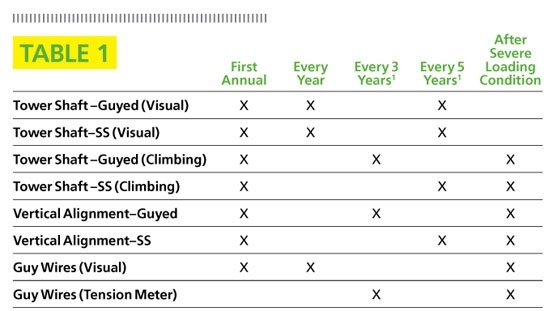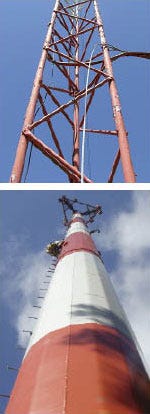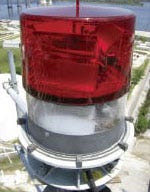Good investmentGood investment
The importance of regular tower and site maintenance cannot be underestimated.
October 1, 2011

Those structures located in hurricane-prone areas should be inspected annually for loose hardware and to ensure that antenna and transmission line attachments are secure. Proper tower maintenance not only helps to maximize the lifespan of the tower, but also helps to maximize the lifespan and financial investment of the radio system.
The key to tower maintenance is the annual inspection of the mechanical structure itself. A good tower crewman will perform a light inspection from the ground each time before climbing, and will subconsciously inspect the tower every step he ascends. However, a thorough, in-depth and all-encompassing inspection consisting of several hundred points should be accomplished on a regular basis.
The Telecommunications Industry Association produced the Structural Standard for Antenna Supporting Structures and Antennas (TIA-222-G is the current revision) which, in addition to procedure, outlines a recommended schedule for tower inspections. This is typically every three years for a guyed tower and five years for a self-support tower, but is recommended annually for coastal areas that are subject to corrosive salt air and high winds. (See Table 1 below.)
The first and most important step is to inspect the tower from the ground. A visual inspection to assess obvious damage to the structure will go a long way toward protecting tower crews from placing themselves in an unsafe situation. It is quite common for unprotected guy points or tower bases to be damaged by vehicles, tractors and lawn mowers — especially lawn mowers. A visual structural inspection should include careful investigation of tower members and guy point foundations, guy point termination plates (including below grade), turnbuckles and sleeves, as well as the alignment of the guy wires and the tower itself.
Most deformations in the tower, which could be a sign of structural damage, can be spotted from the ground. Another important consideration, for guyed towers, is the level of corrosion exhibited by the cotter pins that keep guy wire shackles in place on the guy termination plate. Rusty cotter pins, even more than severely faded paint on a tower, can indicate the lack of a proper maintenance program and should serve as a warning of caution to crews preparing to work at height.
Following the visual inspection on the ground, the inspection continues on the tower and includes documentation, with pictures and recorded heights, of any current or potential defects. Given this information, the owner can undertake corrective action and can track trouble spots and trends that will need to be addressed in the future. The structural inspection at height should include, at a minimum, an assessment of tower legs, cross members, climbing facilities, guy point shackles, tension arms, platforms and walkways, and of course the nuts and bolts that hold it all together. For the proper inspection of large self-supporting towers and monopoles, it also is necessary to rappel down the tower faces that are opposite the climbing face.
While on the tower, the assessor also will evaluate the condition of either the galvanization or the aviation orange and white paint that has been applied to the structure. Galvanization will last the lifetime of the tower, typically only requiring minor repairs due to scratches accumulated during tower delivery and stacking, or from installation of additional hardware such as antenna and cellular sector mounts. On the other hand, a good paint job will last five to eight years at the most and the maintenance of tower paint is crucial to the life of the structure.


Once a tower is painted, the paint always must be kept to Federal Aviation Administration color standards according to FAA Circular AC70/7460-1K. There are two important points to consider. First, the FAA only allows a slight variation in color tolerance, measured on the upper half of the tower, according to its In-Service Orange Color Range chart, and violators of this requirement risk a hefty fine. Second, once the paint on the tower begins to flake off, it takes the under coat of galvanization with it. This exposes the vulnerable steel underneath to the corrosive effects of moisture and salt air — hence the requirement for more routine inspections in coastal regions. For a hollow leg tower, such corrosion can shorten the lifespan of the structure by more than half. Like the cotter pins, the condition of the paint on a tower is an indication of the level and quality of the maintenance provided to the structure. If the paint is bad, chances are the rest of the tower has been neglected as well.
Under current rules, the tower paint does not need to meet FAA color tolerances if the lighting system — on towers that are required to be lighted — is converted from a night-only red-light beacon system to a day/night white strobe system. However, this approach often leads tower owners to neglect the necessary maintenance of painted towers required for the reasons outlined above.
The process used in repainting a tower can extend the life of the paint by several years. Done correctly, a paint job will have at least four steps designed to completely prepare the structure prior to the application of a new coat of paint. If the job is done cheaply, you could be repainting the tower every few years.
Weather also plays an important role in the application of the paint, which needs to be accomplished according to the guidelines of the paint manufacturer.
The steps that should be completed at a minimum are as follows:
Inspect the tower from top to bottom in order to identify elements that exhibit severe corrosion damage that need to be either replaced or more thoroughly treated before repainting.
Execute a rough scrape to remove flaking paint and eliminate any potential for moisture to be trapped and cause corrosion underneath a new paint job.
Treat the tower for rust, preferably with a solution that stops the corrosion process by converting the rust from iron oxide to iron phosphate.
Use a high quality, non-lead-based paint of the appropriate colors.
Just as with the paint color, the lighting requirements on towers over 200 feet, or within five miles of an airfield, are strictly controlled by the FAA. (These guidelines also are outlined in FAA Circular AC70/7460-1K.) Failure to follow them could result in fines in excess of $10,000 per day. Within 30 minutes of the failure of any flashhead (either red or white strobe light) on the tower or of either of the two incandescent bulbs in a beacon (slow flashing red light), a Notice to Airmen must be filed with the FAA.
This typically is accomplished with a brief call to the NOTAM hotline and providing the tower’s antenna registration number. Upon filing, the owner of the structure has 15 days to complete repairs or extend the NOTAM. Once the notice is filed, airplane and helicopter pilots are notified of the structure’s lighting failure and are required to avoid the structure. The FAA is much more lenient for marker bulbs (steady burning lights), only requiring replacement when more than one marker is out at any marker level.
Obstruction lighting systems are susceptible to failure for many reasons including normal fatigue, lightning, sun damage and moisture, and provide another reason why inspections are so important for tower owners. As previously mentioned, routine tower inspections allow owners to track trends that will need to be addressed in the future and to budget for parts and labor. For example, moisture leaks in flashheads and beacons lead to corrosion of electrical parts and connections. This is especially true in flashheads, as the dissipated energy from the strobe interacts with the moisture, which creates ozone. This ozone is a powerful oxidizer and will rapidly decompose exposed metal, leaving a bluish-green tinted coating.
The different types of obstruction lighting systems require various levels of maintenance and range from simple to very complex. A typical incandescent lighting system includes 120 VAC power, a timing circuit and sometimes a dry contact alarm for notification of lighting failure. For the average medium-intensity strobe system, the 1,000 VDC electrical system is more complex and involves multiple timing and charging circuits, resistor-capacitor circuits and transformers. In addition, xenon flashtube systems contain circuit boards with integrated circuits that are more susceptible to power surges and EMI pulses from lightning strikes.
Many tower owners are transitioning to light-emitting diode technologies to improve reliability. While operable on normal 120 VAC power sources, LED units have the same vulnerabilities as do strobe systems, but usually are more expensive to maintain. LEDs do not need replacement as often as incandescent lamps as they do not burn out like normal light bulbs, but instead short-circuit. Often, a few LEDs can fail and the system still will meet FAA requirements for luminosity, which allows for continued use of the flashhead. However, should enough damage be done to LED circuits to drop the brightness of the flashhead below FAA standards, then the entire flashhead might need to be replaced. Most manufacturers do not sell LED flashhead parts for field repair, and opening a flashhead will violate any warranty. In such cases, re-lamping becomes much more expensive than just replacing a single flash tube or bulb.
The final part of any tower inspection should include a physical evaluation of the structure’s various transmission lines, jumpers, connectors and antennas. Transmission lines should be inspected visually along their entire length for signs of damage or fatigue to the outer plastic jacket. Although transmission lines do not require a lot of maintenance, the do have a finite lifespan and are susceptible to damage from the installation of additional antennas, mounts or cellular sectors.
Transmission line hoist grips and line hangers also should be checked and replaced when required, as these mechanically secure the line to the tower. Like transmission lines, antenna jumpers don’t typically need maintenance, but they do get old. More importantly, the weatherproofing on the connectors between the transmission lines, jumpers and antennas should be inspected to make sure it still provides a viable weather seal. If this is questionable, the weatherproofing should be removed to check for corrosion inside the connector, or at least be documented for the customer. Mechanically, antennas require a close-up visual inspection of the mounting hardware, elements and wiring. Charring from electrical sparking and any obvious signs of damage might suggest further electrical testing or an antenna replacement. Hardware corrosion on the antenna mounts should be addressed and corrected to reduce expensive or unexpected repairs in the future.
While the tower is being inspected at height, return loss sweeps of the transmission lines and jumpers can be performed from the ground. Using specialized test equipment, the electrical viability of the transmission signal conductor can be tested from the radio to the antenna. Line sweeps can provide system owners with distance-to-fault (DTF) and voltage-standing-wave-ratio (VSWR) measurements.

The DTF test can provide a distance up the tower in which a problem (defect) could be occurring in the transmission line. Coupled with a climber already visually inspecting the tower, return loss measurements become a powerful tool to quickly locate, evaluate and resolve immediate problems or future issues. More than one transmission line has been repaired due to damage from gunfire.
The SWR test provides a measurement of impedance mismatch that causes a reflection in transmitted power back to the transmitter instead of into the antenna. The ideal VSWR ratio is 1:1 with no reflected power. If the antenna system is old (more than six years), transmission lines and/or jumpers should be disconnected and isolated from the antennas, terminated into 50-ohm loads and then swept. The purpose of this test is to verify the transmission line as a viable component. By so doing, the inspector on the tower has an opportunity to remove old weatherproofing, check for corrosion in the connector and reseal the connections prior to making the final antenna system sweeps.
With a well-thought-out maintenance program and very little planning, a system owner can ensure that the single-most important aspect of any radio system performs to the level for which it was designed, for as long as possible. Tower structures that reach several hundred feet in the air do not come cheaply or easily, but they still are relied upon every day by public-safety agencies.
Ed: Part 2 of this series will present recommended practices for the care and maintenance of radio sites and allied structures.
Todd Mechler began his career with the U.S. Air Force as an electronics technician. He has an electrical engineering degree from Florida State University with a specialization in RF communications. Mechler is a project manager and consultant for Covington, La.–based Tusa Consulting Services and co-owns Southeastern Towers LLC, a tower maintenance and service company in Florida.



